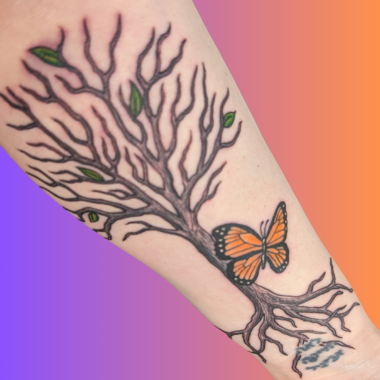Sarcoidosis symptoms and treatments make tattoos a challenge
A symbol of strength isn't so simple with an immune-mediated disease

When I was in high school, my mom and I began an ear-piercing competition. When I came home for breaks during college, we checked each other’s ears to see who had more. In grad school, she told me I was forbidden to pierce anything other than my ears. That’s when I got my first tattoo.
I started out simple: a golden band around my arm with my name. I knew that was something that would never change. Over the next several years, I got a few more, each more meaningful than a simple nameplate.
I have a pair of irises because my mom’s name is Iris, and a lily because my grandmother’s name was Lilly. My husband and I each have half of a yin-yang symbol over our hearts. And of course, I have several butterflies. I truly wear my heart on my sleeve, carrying the people who mean the most with me at all times. They give me strength, courage, and comfort whenever I need them.
In 2012, I got my largest tattoo: those familial flowers and five butterflies on my upper arm. Around the same time, I started seeing my fourth rheumatologist, still trying to figure out what was causing my fatigue, swollen joints, and rashes. At the time, she thought it was either lupus or psoriatic arthritis, though my bloodwork didn’t seem to agree.
Still, she started me on methotrexate and Humira (adalimumab) — medications that suppress the immune system to combat the overactivity and misdirection that cause immune-mediated disease. With that, she said I couldn’t get any more tattoos or piercings because there was an increased risk of infection with a compromised immune system.
When my doctor saw how upset I was, she said that once we got my disease under control, we could revisit the idea. When it was well managed, she explained, we could hold those medications for a week or two to pause immune suppression and reduce the risk of infection. Whew!
Ten years and four rheumatologists later, we still hadn’t gotten to the point of my disease being well managed and under control. When I was diagnosed with sarcoidosis in 2015, there was an added concern: cutaneous sarcoidosis is attracted to tattoos and often forms within inked areas. It felt like I’d never be able to get another tattoo, and it was a significant loss to me.
Balancing safety with what’s important to me
Still, I’ve known many people who have continued to get tattoos, even after their diagnoses. One friend, an arthritis advocate who has been featured in Inked magazine, even wrote an article for CreakyJoints about getting tattooed safely with inflammatory arthritis. Thinking about the tattoos I already have, sarcoidosis developed in only one of five.
So I made a decision. I’d had to hold some medications for the first two COVID-19 vaccines in 2021, and again for my hip replacement last year. If it’s important enough, it’s worth pausing my treatments. And this was important enough to me.
It was during the height of the pandemic that I made this decision, so I couldn’t do it right away. If I wouldn’t go inside a restaurant, I couldn’t go into a tattoo studio. If I wouldn’t allow anyone within 6 feet of me, I couldn’t sit 6 inches from a tattoo artist. If I wouldn’t allow a manicurist access to my nails, I surely couldn’t give a tattooer access to my open skin. So I had to wait. Still.
I’ve been gradually reentering the world over the past year or so — carefully, with masks and distance when possible. So I decided it was time. I consulted my rheumatologist and neurologist to see which medications I might have to hold and for how long to get my next tattoo as safely as possible.

Kerry Wong’s new tattoo is a symbol of strength, hope, and resilience. (Courtesy of Kerry Wong)
I’d had plenty of time to think about it and knew exactly what I would get. It’s inspired by a quote I saw on Facebook several years ago (source unknown): “If you feel like you’re losing everything, remember that trees lose their leaves every year, and they still stand tall, waiting for better days to come.” It felt like the perfect representation of life with a disabling illness like sarcoidosis.
With roots that run through a previous tattoo of my grandmother’s and mother’s Hebrew names framing my own (they are my roots), this tree stands tall, a symbol of hope, strength, and resilience. Five sprouting leaves — a symbolic number with my husband — herald better days to come. A monarch butterfly floats in front to lead my way, reflecting the colors of the tiger lily (for my grandmother) on my shoulder.
I love everything about this tattoo — how it looks, and more importantly, what it means. And I’m already thinking about the next one(s).
Note: Sarcoidosis News is strictly a news and information website about the disease. It does not provide medical advice, diagnosis, or treatment. This content is not intended to be a substitute for professional medical advice, diagnosis, or treatment. Always seek the advice of your physician or other qualified health provider with any questions you may have regarding a medical condition. Never disregard professional medical advice or delay in seeking it because of something you have read on this website. The opinions expressed in this column are not those of Sarcoidosis News or its parent company, Bionews, and are intended to spark discussion about issues pertaining to sarcoidosis.






Robin Poole
I’m so happy you shared your story. I'm not much for tattoos but love the meaning of yours it's beautiful. It's a tough disease I was diagnosed in 1999, I'm 62 now.. Hang in there!! I do lots of natural things. Eat healthy, Acupuncture, it helps too!
🦋 Kerry Wong
Thanks, Robin! I'm sure you've seen so many changes over the past 25 years. We've all got different ways to manage - for me, it's a combination of traditional and alternative/complementary methods. Hope you're doing well!
~🦋
Yvette Pleasants
Kerry, I enjoyed reading your post! Sarcoidosis has a unique way of reshaping the lives of people who are living with the rare illness. I too, share the diagnosis with you. Multisystemic sarcoidosis gives birth to the unknown and makes us do a dance that has to be carefully choreographed. Once you’ve found your rhythm it makes the dance worth dancing! It should not limit our risk-taking to what we desire to get out of the duration of our beautiful lives; within reason of course. Sarcoidosis is by no stretch of the imagination a pleasant medical journey. It's toughest when the body doesn't allow us to do what our minds tell us we can accomplish. I’ve been wrestling with whether or not I wanted to get one final tattoo—you’ve helped me to make a decision and I will discuss it further with my rheumatologist. I’m thrilled for you and your phenomenal ink that has a lovely story of what it means to you. Fortunately, for me, Remicade infusions keep my sarcoidosis in check and I have a Gold Star medical team that is committed and dedicated to giving sarcoidosis patients a better quality of life. I appreciate you, Kerry!
d.a. scott
I wanted to update a tattoo but have the very same concerns and sense of loss. This gave me hope (plus, I love your tattoo)! I'll revisit the conversation with my rheumatologist when we meet again this summer. Fingers crossed!
🦋 Kerry Wong
Thank you, D.A.! You'll have to come back and let us know if you go for another one. Good luck!
~🦋
James Kellogg
Hello wonderful story about strength and being a true warrior. I would love it if I could have a private chat with about some things I want yo do very near future. Please mes a age in private and I eill tell you my goal and ambition regarding Sarcoidosis (myself) and Lupus (my wife) as well. Thank you for your wonderfullinspirational story.
James
Sandra Denise Isaac
Loved your article, especially the tattoo! I’ve stopped my Metoject (without advice). I’m due to have Infliximab in a few weeks but just don’t know…..
🦋 Kerry Wong
Aww, thank you, Sandra. I'd be wary of making substantial med changes without at least discussing with them (even if you ultimately disagree, they may be able to offer suggestions to mitigate other problems that come with stopping a treatment) ... but whatever you decide, I hope it brings you relief.
~🦋
Powlesland
Hello
My sister got diagnosed early this year with chronic pulmonary Sarcoidosis ... 50% lung function she is a Barrister and lectures in university ... Please can you advise on alternative therapies like Turmeric ... please she was on high dose steroids now on lower dose but too many side effects .... Thank you so much. I have only just signed up to this . Kind regards
🦋 Kerry Wong
How wonderful that she has such a supportive sibling in you. There's definitely a balance we must find with treatments and side effects, each doing the best we can to manage our condition. You may some helpful information at https://sarcoidosisnews.com/living-with-sarcoidosis/. Hope that helps!
~🦋